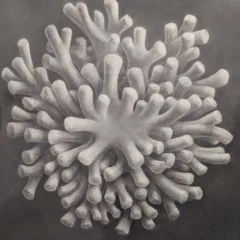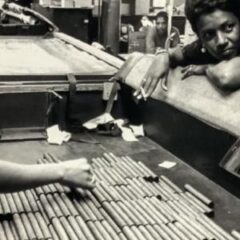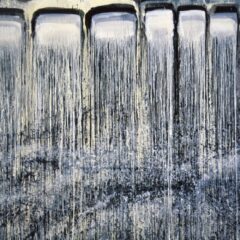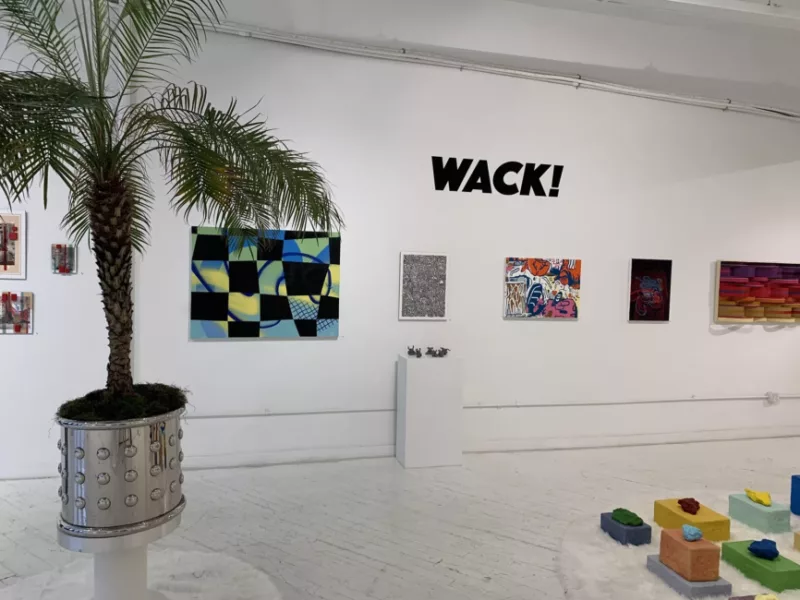
When you climb the wooden stairs at 723 Chestnut to the second floor and enter the multi-hyphenate world of HOT BED, a self-described “gallery and creative lifestyle space in Philadelphia that unites art, horticulture, and design,” be prepared to stay for a spell and laugh. “WACK!” is an exuberant salon-style show worth spending time with and wandering through the labyrinthine space where plants and furnishings, available for purchase, co-mingle with the 59 works of art in the exhibition.
The curatorial proposition for “WACK!” is “when the world gets too weird to comprehend, art and design of the moment reflect that. Weirdness is becoming the new norm.” HOT BED put out a call for artists to “lean into the absurdity of our present moment… and think creatively about topics of interest… which include but are not limited to boldness, magic, politics, surrealism, weirdness.” From over 100 artists who submitted work, 24 were selected, and most have multiple works in the exhibition. Some pieces announce their weirdness with bright colors and loud loopiness from across the large space, like the clothing designer Jordan Princiotta’s “Infection,” a collection of 3-to-4-foot green worm-like entities that tumble from the 18’ ceiling to the floor, or Christopher Richards’s series “Assorted movement stones,” a collection of painted stones and concrete chunks set atop contrasting colored boxes. The group of 16 relate to a 12-hour music composition. The works sit on one of several large round white plush rugs used in the exhibition. Not the kind of installation accoutrement that every gallery has.
Other works in the show are more demure. You have to get close enough to appreciate their subtleties, like Krista Dedrick-Lai’s “Pocket 10.” This odds-and-ends collection of clothing, including the underwire from a bra, coalesces into a work both transcendent in its veiled overlays, and funny in its cartoony lines and references. There’s more fun and subversion right below it. “Grid on Grid” by Briell Giancola is a painted work on cut paper. The grid lines waft and wobble, playing with its shallow framed space by casting a shadow against a gradient background.
A different sort of spatial sport takes place in the works of Mehgan Abdel-Moneim. The artist is also a dancer. She plays with depth and our expectation of the picture plane in a series of three works called “Tax Season Nest.” The background images for the series are photographs of a room filled with suspended, crumpled tax documents. (Who among us can’t relate to tax time feeling like being caught in a blizzard?) Over the images the artist choreographs layers with colored vertical stripes and three-dimensional painted blocks, giving the effect of a D.I.Y. hologram.
The series is emblematic of a trend with several pieces in the exhibition that breakdance with formalism, such as Aaron Harel’s wall relief assemblage, “Brilliant.” The work is composed of rows of different-sized convex sections of cylinders that undulate horizontally in a curious rhythm within a 25-inch-high by 49-inch-wide frame. The cylindrical sections are unified by horizontal bands of colors. The palette suggests a landscape vanishing into a purple horizon during golden hour. Though static, there is implied movement on every axis, which is to say, there’s a lot going on in this piece visually. But wait, there’s more! The cylindrical sections are “up-cycled drum shells,” a material that adds a conceptual ba-dum-bump punctuation to the work.
There are several standouts that employ traditional materials in surprising ways. The ceramicist Marguerita Hagan’s “Champagne & Crinoline” is an exquisitely detailed kiln-fired earthenware sculpture depicting a species from the stinkhorn family of fungus, sometimes referred to as the bridal veil or crinoline stinkhorn, which thrives on rot and decay. In Hagan’s portrayal, the billowing, peek-a-boo mesh ceramic skirt is festooned with knobby golden highlights giving it a jewel-like bearing, a far cry from its source subject.
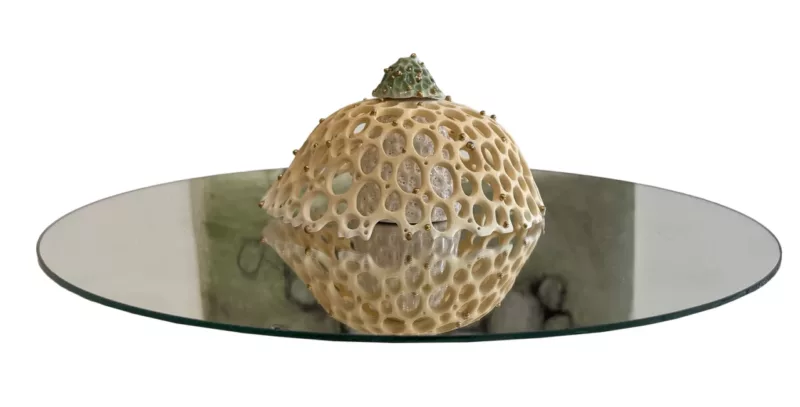
A few steps away, three of Hagan’s works from her “Rongorongo” series will stop you in your tracks. Their wild surface coloration results from the alchemy of pit firing. Each of these fluid, vaguely figuratively shaped works would fit in your hand, yet they feel anything but small. The shapes are based on the mysterious hieroglyphic language covering a handful of artifacts found on Rapa Nui, also known as Easter Island.
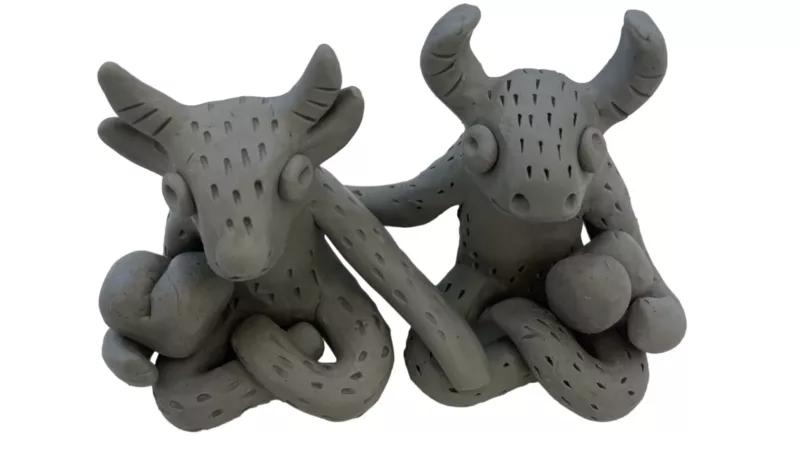
Crossing the gallery, you’ll find another group of small, figurative sculptures by Aubrey Fink / Wolfdog from her “Guardian” series. These works are made of plasticine, a non-hardening clay typically used as the waste positive in a mold made to cast with durable material. Instead, Fink / Wolfdog sends these fragile, funny, gray-green, long-eared, curved-horned creatures out into the world, placing them in spots around Germantown. When they are sold, the artist commits to attending to them if they suffer any maladies. Their vulnerability strengthens the work.
Back to the wall works. Some standouts that exemplify the exhibition’s title are Henry Merker’s black and white paint pen on board “Colony of Microflora.” It looks like a magnification of a microbial jamboree on a brick thrown by Ignatz the mouse at Krazy Kat. More portraits of anxiety are spotlighted in cartoon fashion via Carmel Dor’s oil on canvas, “Pit in Our Stomach” and via the shimmering abstracted beauty that Jeremiah Watson coaxes from fuel spills and mutated algae in his “Gunk” series of giclee prints.
I mentioned that HOT BED is labyrinthine. Turn a corner and you’ll enter a nook where a neon element from Alex Schechter’s “The Transcendent Nadir” skewers a drawing of a calf and bathes its neighboring works in a pink glow. Climb a set of steep interior stairs to watch “The Falling Lovers” a short animation by Chen-Yi Wu. During the couple’s descent they make impossible, absurd requests of each other. A wack portrait of love during these weird and worrisome times.
“Wack” is up at HOT BED through August. 12, 2023.


